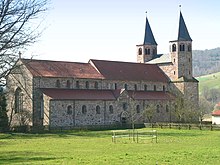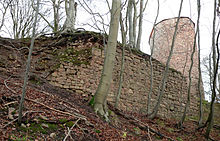Hemeln
|
Hemeln
City of Hann. Münden
|
|
|---|---|
| Coordinates: 51 ° 30 ′ 3 ″ N , 9 ° 36 ′ 23 ″ E | |
| Height : | 115 m above sea level NN |
| Residents : | 923 (Dec. 31, 2015) |
| Incorporation : | 1st January 1973 |
| Postal code : | 34346 |
| Area code : | 05544 |
|
View over the Weser to Hemeln
|
|
Hemeln is a district of the city of Hann. Münden . The village is twelve kilometers down the Weser from the city center of Hann. Mouth. The village with a total of 992 inhabitants includes the two villages Glashütte with 100 and Bursfelde with 40 inhabitants. The three villages lie along the Weser at the foot of the Bramwald . Until the territorial reform in 1973, the three villages formed an independent municipality. Local mayor is Alfred Urhahn.
history
Bronze Age artefacts such as arrowheads, flint tools, shards and the floor plan of an oven prove that the area around Hemeln was settled in prehistoric times . The finds were made "at the Olen Dreischeuwer" about two kilometers north of Hemeln.
The place was first mentioned in the middle of the 9th century when Ludwig the Pious transferred Hemeln to the Corvey monastery in 834 . Through a comparison between Duke Erich I of Braunschweig and Landgrave Philip of Hesse , the place came under the sovereignty of Braunschweig on March 11, 1538. Hemeln lived mainly from agriculture.
In the early Middle Ages the place appeared under the names Hemlion , Hemli , Hamelen , Hemelen and Heymeln , the place name has been known in its current form since 1479. Since the late early modern period , the population has increased continuously. While 450 people lived in the village in 1689, in 1939 there were already 732, while in 1979 the 1000 mark was reached. On January 1, 1973, Hemeln and its districts were incorporated into the city of Münden. In 1990 Hemeln won the Germany-wide competition Our village should become more beautiful .
Attractions
Hemeln is a popular destination because of its location in the Weser Valley and the ferry to Veckerhagen on the other side of the Weser . There is a well-known traditional inn right by the ferry.
There are numerous well - kept half-timbered houses in the village itself , some of which have elaborately designed house inscriptions. Of the houses, the Bramwald Forestry Office stands out, a magnificent half-timbered building, which was built around 1700 by the shipbuilder J. Kellner.
church
The old church was built in 1681 after the Thirty Years War . It replaced a smaller church which, like the whole village, was damaged during the war. The tower of the church was built around 1200 as a defense tower made of rubble masonry. The tower has also been a bell tower since the end of the Middle Ages. In 1686 the church received a new wooden altar, which was created by the artist Fabaring . The altar has a triptych as an attachment. It shows the Easter story in three pictures:
- Below the last supper with Jesus in the midst of his disciples,
- in the middle the crucifixion of Christ with Mary and John and the four evangelists and
- above the risen Christ with arms open to the viewer.
The church was given a gallery in the 18th century to create more space in the church. In 1966 the church was completely renovated and rebuilt. The pulpit, which was previously part of the upper altar wall, was given a new place. The floor made of red sandstone slabs was replaced with Jura marble. The oak benches and other interior fittings were replaced.
Bramburg
Above the village is the Bramburg , which was first mentioned in 1063. It was expanded to protect the Bursfelde monastery, founded in 1093 by Heinrich the Fetten , son of Otto von Northeim . In the 13th century the castle belonged - at least in part - to the Corvey monastery , which owned goods in the Bramwald. In 1279 the Bramburg came into the possession of Albrecht the Feisten . The lords of Stockhausen had been castle men since the beginning of the 14th century. In 1452 traders complained for the first time about robber barons. When Thuringian traders were robbed in 1458 and the city of Göttingen did not stop the hustle and bustle, Landgrave Wilhelm III burned . down the castle. In 1494 the rebuilt castle was destroyed again. It was rebuilt at the beginning of the 16th century, but soon abandoned.
Today only the castle tower remains, the foundations of the castle walls can still be seen.
Hünenburg Hemeln
A few hundred meters south of the Bramburg are the remains of the Hünenburg Hemeln on the western foothills of the Hünenkopf in the forest . It is assumed that it originated in the first centuries after Christianity and that it existed up to around the year 800 due to the discovery of Franconian equestrian warrior equipment. The triangular complex with no traces of settlement inside is almost seven hectares in size.
Bursfelde Monastery

The Bursfelde Monastery, founded in 1093, now serves as a Protestant conference center.
Hemelner disc cross stone
Originally located in the Hemelner Feldmark, the Scheibenkreuzstein was then moved to the eastern edge of Weserstraße, where it is now at the height of a parking lot for hikers. It has two similar Maltese crosses on the front and back , one of which is washed out and slightly damaged due to the weather. Above the crosses there are traces of whetting . There are no known records about this stone.
Culture
The theater association “Bühnenfreunde Hemeln” has existed since 1965. In addition to regular theater performances, the association makes contributions in Hemelner dialect to local events and serves as an interface to other cultural groups such as folk dance and school children groups. One of the oldest clubs in the village is the men's choir "Concordia" Hemeln, founded in 1860. In addition, an annual shooting festival with cup shooting takes place.
literature
- Willi Osenbrück: Hemeln 834–1984. Contributions to the history of an Oberweser village. Self-published, o. O. 1984, 443 pages
- Heinz Potthast: Examples of how a cultural landscape becomes in the Hemeln-Bursfelde area. Field names, old roads, desolation. Sydekum writings on the history of the city of Münden 9th self-published, Münden 1984
- Walter Henckel: On the Weser cycle path near Hemeln. On a discovery tour between Hannoversch Münden and Bursfelde . Ed. Culture and Nature Funding Association Hemeln e. V., Husum Verlag, Husum 2007
Web links
- www.hemeln.de
- Film contribution Heimat ist ... op'n Dorp. Hemeln - half-timbered and heavy metal on the Weser at NDR.de on December 13, 2015 (1:28 hours)
Individual evidence
- ↑ a b City of Hann. Münden: population (as of December 31, 2015, accessed on July 18, 2016)
- ↑ Erwin May: Münden and surroundings . Erwin May, Hann. Münden 1980, p. 179 f .
- ^ Federal Statistical Office (ed.): Historical municipality directory for the Federal Republic of Germany. Name, border and key number changes in municipalities, counties and administrative districts from May 27, 1970 to December 31, 1982 . W. Kohlhammer GmbH, Stuttgart and Mainz 1983, ISBN 3-17-003263-1 , p. 213 .
- ^ Website of the operator of the ferry Hemeln-Veckerhagen
- ↑ Eberhard Michael Iba: In the footsteps of the Brothers Grimm from Hanau to Bremen. Fairy tales, sagas, stories . Pustet, Regensburg 1978, ISBN 3-7917-0536-9 , pp. 143 .
- ↑ Theater Association Bühnenfreunde Hemeln e. V. , accessed on January 21, 2014
- ↑ 150 years of choir history of the MGV Hemeln on the website of the Hessisch / Niedersächsische Allgemeine, accessed on January 21, 2014








